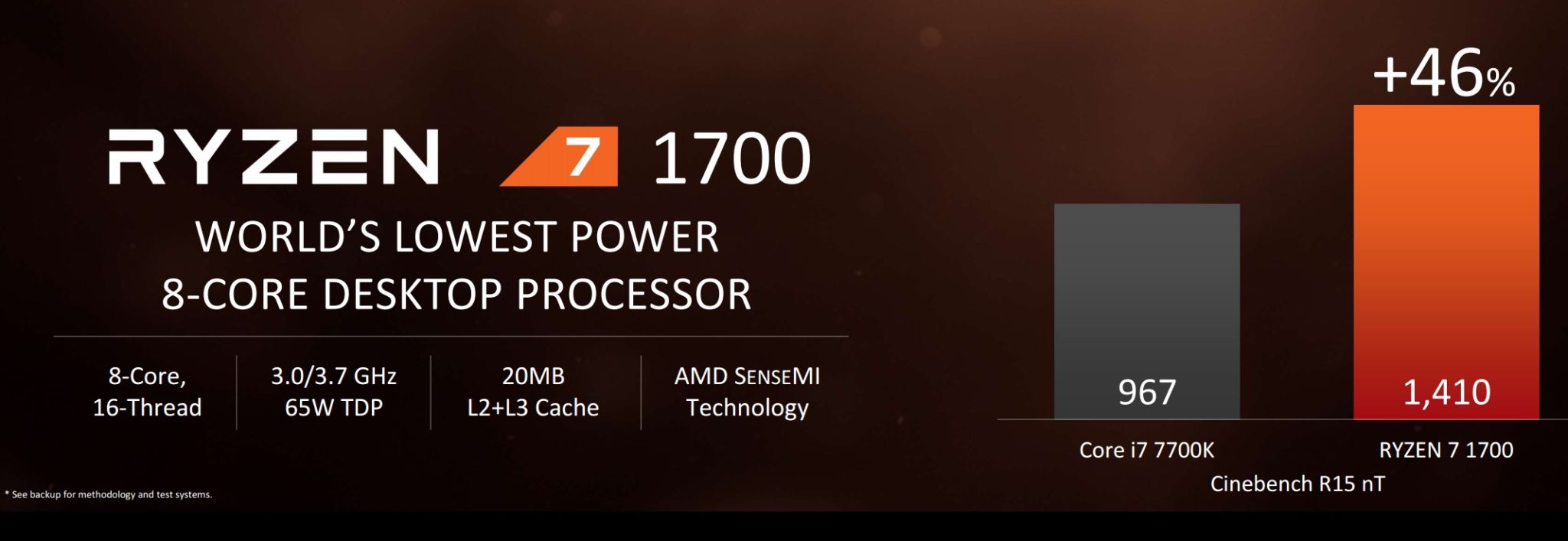AMD Has Ryzen And What It Means For The Future of PC Building/Gaming
For most PC builders out there, ever since AMD announced the Zen architecture back in 2015, we’ve been waiting for its release as AMD’s previous CPU releases have been lackluster in comparison to offerings from competitor Intel. Now, with Ryzen, the Zen architecture has finally been released, and the PC building community is waiting with bated breath to see whether it can live up to the hype or come out another dud.
What is Zen/Ryzen?
Zen is AMD’s latest CPU architecture, and the Ryzen line will be the CPUs built on Zen. CPU architecture represents how the CPU layout is designed, indicating where the cores, cache, and other processing elements are, as well as the instruction set used. This is what Zen’s architecture look like, taken from AMD’s website.

The five main features of the Zen architecture that AMD highlights on their site are: Pure Power, Precision Boost, Extended Frequency Range (XFR), Neural Net Prediction, and Smart Prefetch. Pure Power aids in power efficiency and power consumption monitoring. Precision Boost works in tandem with Pure Power to optimize power consumption in relation to the performance required as it tunes clock speeds on the fly to adjust to the programs or games you’re currently running. Extended Frequency Range, which is only found on SKUs that have an X on them (eg. 1800X), is basically an automatic overclocker; it would increase your clockspeeds automatically as long as you have the thermal headroom for it. Neural Net Prediction uses neural networks that analyze app usage to accelerate the execution of programs at the CPU instruction level. Smart Prefetch predicts data needed for faster performance and load times.

Why is Ryzen a big deal?
Ryzen is the first lineup from AMD in years that’s been shown to be competitive with Intel’s offerings at the price and performance level. Disappointments like the very hyped Bulldozer have only cemented AMD’s lackluster performance. How lackluster, exactly, can be answered with a few benchmarks: A quick glance at Geekbench‘s records show that Intel is clearly on top of AMD in terms of single and multi core performance. Further benchmarks from using 3D rendering software Blender show that Intel’s 4 core/8 thread 4790K outperforms AMD’s 8 core/8 thread FX-9590 in rendering by about 11 seconds. In gaming benchmarks from Hardware Unboxed using Intel’s i5 6400 and AMD’s FX-8320, we can see that in a test run of Fallout 4, the overclocked FX chip pushed out fewer frames per second than the stock, non-overclocked i5 6400.
Given all this, what does AMD have to offer with Ryzen that has got everyone excited?
The Ryzen Lineup
R7: enthusiast/professional grade
We’ll start with the line that’s coming out soon, the R7.
The R7 has three SKUs set to come soon: 1800X, 1700X, and the 1700
The 1800X’s specs are as follows. It has 8 cores/16 threads with a base clock speed of 3.6GHz which can boost to 4.0GHz. The X denotes the XFR feature, a form of dynamic overclocking that will boost clocks as long as the thermal headroom is available. This isn’t to be confused with the ability to manually overclock, as Ryzen processors, given a motherboard based on the X370, B350, or X300 chipsets, will be able to overclock. This comes in contrast to Intel, whose only overclockable processors are the “K” CPUs, as well as the Pentium G3258.
The 1800X has 20MB cache, a TDP (thermal design power) of 95 watts, and a price tag of $499. (around PHP25,000) In AMD’s benchmarks with Cinebench, it’s shown to be better than, or at the very least on par with the performance of Intel’s i7 6900K (8 core/16 thread, 3.20-3.7GHz, 140w TDP) which Intel is selling for around $1000. (around PHP50,000) It’s also tested to be faster on a Megatasking benchmark where Blender, Handbrake and other programs run/render simultaneously and 1800X came out on top.

Moving on to the 1700X, it has 8 cores/16 threads running at 3.4GHz base clock with 3.8GHz boost clock and like the 1800X it has the XFR feature. It has 20MB cache, 95 watts TDP, and costs $399. (around PHP20,000) This is AMD’s answer to the i7 6800K (6 core/12 thread, 3.4-3.6GHz, 140w TDP) retailing at around $440. (around PHP22,000) AMD shows on their Cinebench benchmarks that, yes, it does perform better than the 6800K.

The last chip on the R7 lineup is the 1700 with 8 cores/16 threads at 3.0GHz base and 3.7GHz boost. It doesn’t have XFR but as long as you put it on an overclocking motherboard, it will be manually overclockable. It’s rocking 20MB cache with a 65 watt TDP which is the lowest wattage among all the 8 core/16 thread processors on the market. It retails for $329. (around PHP16,000) AMD’s pricing for this CPU will put this up against Intel’s i7 7700K. (4 cores/8 threads, 4.20-4.50GHz, 91w TDP) The 1800X and 1700X do not come with a cooler as it is assumed that you will be buying high-end aftermarket coolers for them, but the 1700 will come with their new RGB Wraith air-cooler.

Coming Soon
Leaving the R7s, we move on to the R5 lineup which is made up of the 6 core/12 threads and 4 core/8 thread SKUs. Now the R5s and R3s won’t be coming soon, but AMD did say that they are releasing it in Q2 and in the 2nd half of this year, respectively. That said, this is the info that we have on the R5s and R3s from wccftech.
The R5 lineup is aimed at the mid-range performance market. The 6 core/12 thread R5s are 1600x, Pro 1600, Pro 1500, 1500. The Pro processors’ clockspeeds are TBD while the 1600X and 1500 run at 3.6-4.0GHz and 3.2-3.5GHz, respectively. The 1600s are a 95 watt TDP while the 1500s are at 65 watts. All the 6 core/12 thread processors have 16MB cache. The prices on these range from $219-259. (PHP11,000-13,000) On the lower end of the R5 processors are the 4 core/8 thread processors: 1400X, Pro 1400, Pro 1300, and 1300. The Pro processors speeds are, again, TBD but 1400X and 1300 run at 3.5-3.9GHz and 3.2-3.5GHz, respectively. All of the 4 core/8 thread CPUs have 65 watt TDPs and 8MB of cache. The prices on these range from $165-199. (PHP8,000-10,000)
The R3 will be their low-end budget lineup. The R3 consists of 1200X, Pro 1200, 1100, and Pro 1100. Again clockspeeds are TBD for the Pro processors and the 1200X and 1100 run at 3.4-3.8GHz and 3.2-3.5GHz, respectively. They all have 8MB cache and 65 watt TDPs. The prices ranges from $119-149. (PHP6,000-7,500)
So that’s the Ryzen lineup but what does this mean for the CPU market going forward? What will happen if Ryzen turns out to be all that it promises to be?
Implications of Ryzen’s Success
The obvious implication of Ryzen’s success is Intel lowering their prices as we finally see some competition in the CPU market. We’ve mentioned earlier that Intel has practically been monopolizing the CPU market as of late, especially in the higher-end market. Now that we’ve seen that the R7 1800X can compete with the 6900K, for half the price, Intel needs to respond either by coming up with something equally compelling in price and performance or lower their current prices to match the Ryzen processors. In fact, it’s not just 6900K that needs to be lowered, the 6800K and the 7700K need to follow suit as well. And if the performance would carry on to the to-be-released R5s and R3s, prices all across the board for Intel processors would need to adjust if Intel would want to sell their CPUs.
Another effect of this is Intel waking up from their dormant and complacent state. Looking at the recent update from Intel’s Skylake to Kaby Lake platform, the performance gains are probably unnoticeable unless you look at the benchmarks. Looking at Hardware Unboxed’s comparison of Kabylake and the other Intel CPU generations the performance gains are very slight with Kaby Lake having a 10% gain at most against Skylake, and in fact this is solely due to clock speed improvements, as there is no IPC benefit between Skylake and Kaby Lake. If Ryzen turns out to be a success, Intel will have to put their R&D to work to come up with something that can rival or go beyond AMD’s new technology. They’re going to have to step up their game when they release Coffee Lake and Cannon Lake in the future.
The last thing that could come out of this is the prevalence of more cores/threads in mainstream PCs. Outside of the professional and enthusiast realm, we might see more cores on mainstream CPUs especially looking at the price and performance that AMD’s Ryzen is offering. What more cores on the mainstream means for us, especially gamers, is that developers may consider optimizing games to run better and make full use of the higher core count. We might see more intricate games that have high quality graphics and require more CPU power a few years down the line depending on how successful and popular Ryzen’s CPUs will be.
With Ryzen coming out and the GTX 1080 Ti released just before it, the PC building scene is an exciting place to be right now. Let’s not forget that AMD also teased high-end GPUs back in CES, showing an engineering sample of their upcoming Vega GPU. But let’s not get ahead of ourselves. Ryzen is within our grasp and reviewers and people will soon give us their answer to the question: “Has AMD Ryzen?”
EDIT: BENCHMARKS HAVE RELEASED
Link to Gamers Nexus and Hardware Unboxed‘s benchmarks.




